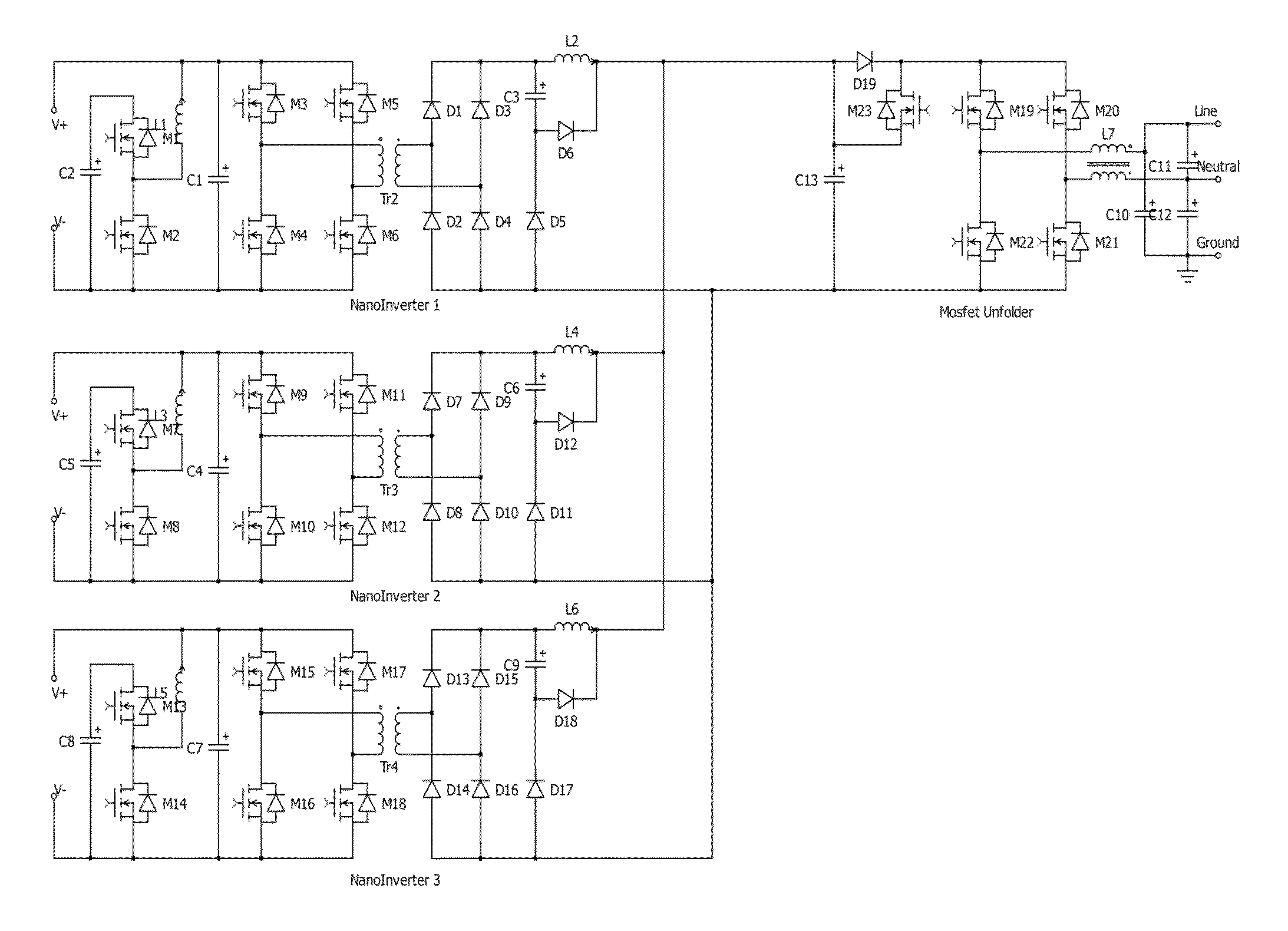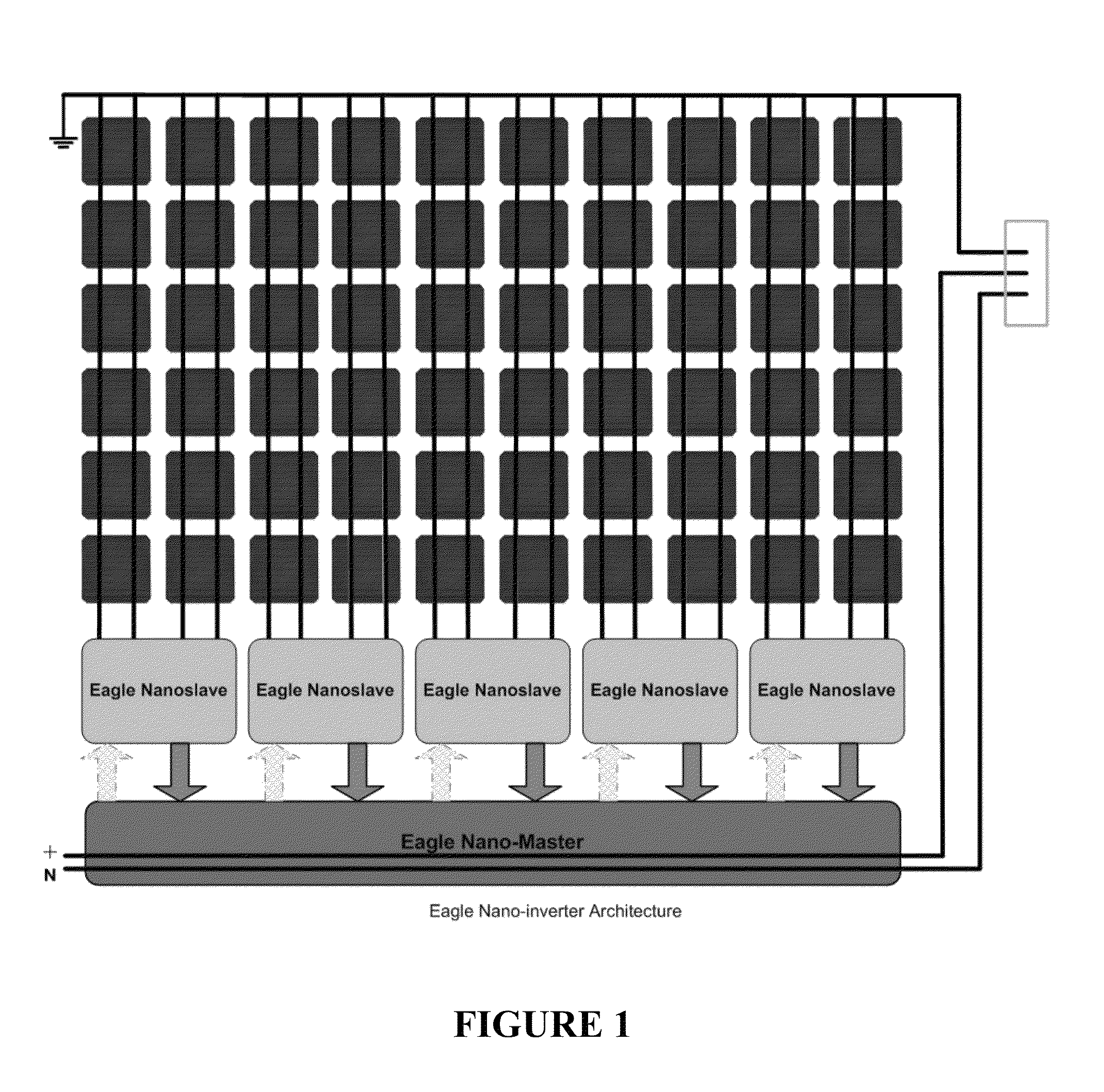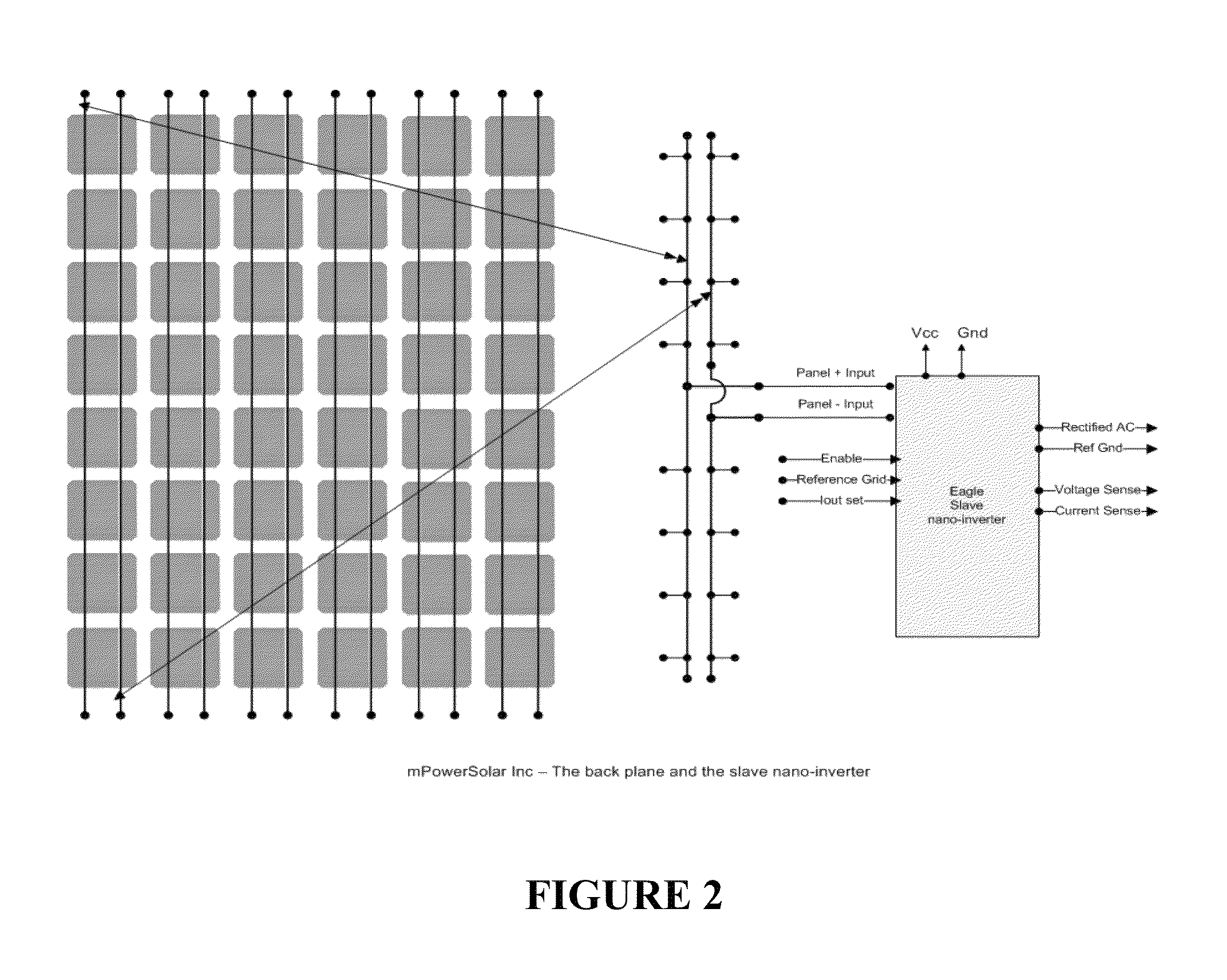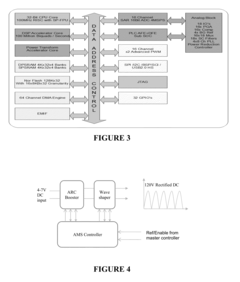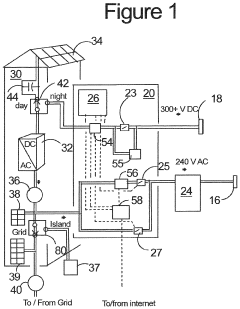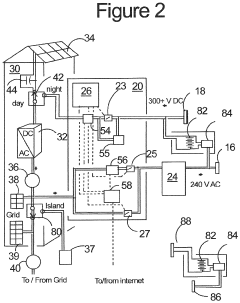Advances in Solar Inverter Hardware for Grid Integration
JUL 17, 20259 MIN READ
Generate Your Research Report Instantly with AI Agent
Patsnap Eureka helps you evaluate technical feasibility & market potential.
Solar Inverter Evolution and Objectives
Solar inverter technology has undergone significant evolution since its inception, driven by the growing demand for renewable energy integration into the power grid. The journey began with simple, grid-tied inverters that converted DC power from solar panels to AC power for home use. These early models were limited in functionality and efficiency, often struggling to maintain stable output under varying solar conditions.
As the solar industry expanded, inverters evolved to meet more complex grid requirements and improve overall system performance. The introduction of maximum power point tracking (MPPT) technology marked a crucial milestone, allowing inverters to optimize power output by constantly adjusting to changing environmental conditions. This advancement significantly increased the efficiency of solar energy systems, making them more economically viable for widespread adoption.
The next major leap came with the development of smart inverters, capable of two-way communication with the grid. These intelligent devices could respond to grid signals, adjusting their output to help stabilize voltage and frequency. This capability became increasingly important as the penetration of solar energy in the grid grew, necessitating more sophisticated grid management techniques.
Recent years have seen a focus on enhancing the grid support functions of solar inverters. Modern inverters are now equipped with advanced features such as reactive power control, low voltage ride-through, and anti-islanding protection. These capabilities allow solar systems to actively contribute to grid stability, rather than being passive energy producers.
The current objectives for solar inverter hardware development are multifaceted, addressing both technical and economic challenges. Key goals include further improving efficiency to maximize energy yield, enhancing reliability to reduce maintenance costs, and increasing power density to minimize installation footprints. There is also a strong push towards developing more flexible and scalable inverter architectures that can adapt to diverse system sizes and configurations.
Another critical objective is to improve the grid integration capabilities of solar inverters. This involves developing more sophisticated control algorithms and communication protocols that enable seamless interaction with smart grid systems. The aim is to create inverters that can dynamically adjust their output based on real-time grid conditions, contributing to overall system stability and reliability.
Looking ahead, the industry is setting ambitious targets for the next generation of solar inverters. These include achieving ultra-high efficiency levels approaching 99%, implementing advanced AI-driven predictive maintenance features, and developing inverters with built-in energy storage management capabilities. The ultimate goal is to create a new class of inverters that not only convert solar energy but also serve as intelligent nodes in a decentralized, renewable-powered grid infrastructure.
As the solar industry expanded, inverters evolved to meet more complex grid requirements and improve overall system performance. The introduction of maximum power point tracking (MPPT) technology marked a crucial milestone, allowing inverters to optimize power output by constantly adjusting to changing environmental conditions. This advancement significantly increased the efficiency of solar energy systems, making them more economically viable for widespread adoption.
The next major leap came with the development of smart inverters, capable of two-way communication with the grid. These intelligent devices could respond to grid signals, adjusting their output to help stabilize voltage and frequency. This capability became increasingly important as the penetration of solar energy in the grid grew, necessitating more sophisticated grid management techniques.
Recent years have seen a focus on enhancing the grid support functions of solar inverters. Modern inverters are now equipped with advanced features such as reactive power control, low voltage ride-through, and anti-islanding protection. These capabilities allow solar systems to actively contribute to grid stability, rather than being passive energy producers.
The current objectives for solar inverter hardware development are multifaceted, addressing both technical and economic challenges. Key goals include further improving efficiency to maximize energy yield, enhancing reliability to reduce maintenance costs, and increasing power density to minimize installation footprints. There is also a strong push towards developing more flexible and scalable inverter architectures that can adapt to diverse system sizes and configurations.
Another critical objective is to improve the grid integration capabilities of solar inverters. This involves developing more sophisticated control algorithms and communication protocols that enable seamless interaction with smart grid systems. The aim is to create inverters that can dynamically adjust their output based on real-time grid conditions, contributing to overall system stability and reliability.
Looking ahead, the industry is setting ambitious targets for the next generation of solar inverters. These include achieving ultra-high efficiency levels approaching 99%, implementing advanced AI-driven predictive maintenance features, and developing inverters with built-in energy storage management capabilities. The ultimate goal is to create a new class of inverters that not only convert solar energy but also serve as intelligent nodes in a decentralized, renewable-powered grid infrastructure.
Grid Integration Market Analysis
The global market for solar inverter hardware for grid integration is experiencing significant growth, driven by the increasing adoption of renewable energy sources and the need for efficient power management systems. As countries worldwide strive to reduce their carbon footprint and transition towards cleaner energy solutions, the demand for advanced solar inverter technologies has surged.
The market size for solar inverter hardware is projected to expand substantially in the coming years, with a compound annual growth rate (CAGR) expected to remain in the double digits. This growth is attributed to several factors, including government incentives, declining costs of solar photovoltaic (PV) systems, and the rising awareness of environmental sustainability.
Geographically, Asia-Pacific leads the market, with China and India being the primary contributors to the region's dominance. Europe follows closely, with countries like Germany, Italy, and Spain at the forefront of solar energy adoption. North America, particularly the United States, is also witnessing rapid growth in the solar inverter market.
The residential sector represents a significant portion of the market, as homeowners increasingly invest in rooftop solar installations. However, the utility-scale segment is expected to grow at a faster rate, driven by large-scale solar projects and government initiatives to increase renewable energy capacity.
Key market trends include the shift towards smart inverters with advanced grid support functions, such as voltage regulation and frequency control. These features enable better integration of solar power into existing grid infrastructure, addressing concerns about grid stability and reliability.
Another notable trend is the increasing demand for hybrid inverters that can manage both solar PV and energy storage systems. This integration allows for more efficient energy management and provides backup power during grid outages, enhancing the overall value proposition for consumers.
The competitive landscape of the solar inverter market is characterized by a mix of established players and innovative startups. Leading companies are investing heavily in research and development to improve inverter efficiency, reduce costs, and enhance grid integration capabilities. Mergers and acquisitions are also common as companies seek to expand their product portfolios and geographical reach.
Challenges in the market include the need for standardization of grid codes and regulations across different regions, which can impact product development and market entry strategies. Additionally, the intermittent nature of solar power generation poses challenges for grid stability, driving the need for more advanced inverter technologies and energy storage solutions.
The market size for solar inverter hardware is projected to expand substantially in the coming years, with a compound annual growth rate (CAGR) expected to remain in the double digits. This growth is attributed to several factors, including government incentives, declining costs of solar photovoltaic (PV) systems, and the rising awareness of environmental sustainability.
Geographically, Asia-Pacific leads the market, with China and India being the primary contributors to the region's dominance. Europe follows closely, with countries like Germany, Italy, and Spain at the forefront of solar energy adoption. North America, particularly the United States, is also witnessing rapid growth in the solar inverter market.
The residential sector represents a significant portion of the market, as homeowners increasingly invest in rooftop solar installations. However, the utility-scale segment is expected to grow at a faster rate, driven by large-scale solar projects and government initiatives to increase renewable energy capacity.
Key market trends include the shift towards smart inverters with advanced grid support functions, such as voltage regulation and frequency control. These features enable better integration of solar power into existing grid infrastructure, addressing concerns about grid stability and reliability.
Another notable trend is the increasing demand for hybrid inverters that can manage both solar PV and energy storage systems. This integration allows for more efficient energy management and provides backup power during grid outages, enhancing the overall value proposition for consumers.
The competitive landscape of the solar inverter market is characterized by a mix of established players and innovative startups. Leading companies are investing heavily in research and development to improve inverter efficiency, reduce costs, and enhance grid integration capabilities. Mergers and acquisitions are also common as companies seek to expand their product portfolios and geographical reach.
Challenges in the market include the need for standardization of grid codes and regulations across different regions, which can impact product development and market entry strategies. Additionally, the intermittent nature of solar power generation poses challenges for grid stability, driving the need for more advanced inverter technologies and energy storage solutions.
Current Inverter Technology Challenges
Solar inverter technology has made significant strides in recent years, yet several challenges persist in the quest for seamless grid integration. One of the primary issues is the need for improved power quality and grid stability. As the penetration of solar energy increases, inverters must be capable of providing advanced grid support functions, such as reactive power control and voltage regulation. However, current inverter designs often struggle to meet these demands while maintaining high efficiency and reliability.
Another significant challenge is the management of harmonics and electromagnetic interference (EMI). The switching nature of inverters can introduce harmonics into the grid, potentially causing power quality issues and equipment malfunctions. Mitigating these effects requires sophisticated filtering techniques and advanced control algorithms, which can increase complexity and cost.
The variability of solar power output presents a unique challenge for inverter technology. Rapid fluctuations in solar irradiance due to cloud cover or other environmental factors can lead to sudden changes in power output. Current inverters often struggle to respond quickly enough to these variations, potentially causing grid instability. Developing more responsive and adaptive control systems is crucial to address this issue.
Thermal management remains a critical concern in inverter design. As power densities increase and inverters become more compact, efficient heat dissipation becomes increasingly challenging. Overheating can lead to reduced efficiency, shortened lifespan, and potential failures. Innovative cooling solutions and advanced materials are needed to overcome these thermal limitations.
Cybersecurity is an emerging challenge in the realm of solar inverters. As these devices become more connected and integrated with smart grid systems, they become potential targets for cyber attacks. Ensuring robust security measures without compromising performance or increasing costs significantly is a delicate balance that current inverter technologies must address.
Lastly, the push for higher power densities and lower costs presents ongoing challenges. While advancements in semiconductor technology, such as wide-bandgap materials like silicon carbide (SiC) and gallium nitride (GaN), offer promising solutions, their integration into commercial inverter designs still faces hurdles in terms of cost, reliability, and manufacturing scalability.
Addressing these challenges requires a multidisciplinary approach, combining innovations in power electronics, control systems, materials science, and software engineering. As the solar energy sector continues to grow, overcoming these technological hurdles will be crucial for realizing the full potential of solar power in our future energy landscape.
Another significant challenge is the management of harmonics and electromagnetic interference (EMI). The switching nature of inverters can introduce harmonics into the grid, potentially causing power quality issues and equipment malfunctions. Mitigating these effects requires sophisticated filtering techniques and advanced control algorithms, which can increase complexity and cost.
The variability of solar power output presents a unique challenge for inverter technology. Rapid fluctuations in solar irradiance due to cloud cover or other environmental factors can lead to sudden changes in power output. Current inverters often struggle to respond quickly enough to these variations, potentially causing grid instability. Developing more responsive and adaptive control systems is crucial to address this issue.
Thermal management remains a critical concern in inverter design. As power densities increase and inverters become more compact, efficient heat dissipation becomes increasingly challenging. Overheating can lead to reduced efficiency, shortened lifespan, and potential failures. Innovative cooling solutions and advanced materials are needed to overcome these thermal limitations.
Cybersecurity is an emerging challenge in the realm of solar inverters. As these devices become more connected and integrated with smart grid systems, they become potential targets for cyber attacks. Ensuring robust security measures without compromising performance or increasing costs significantly is a delicate balance that current inverter technologies must address.
Lastly, the push for higher power densities and lower costs presents ongoing challenges. While advancements in semiconductor technology, such as wide-bandgap materials like silicon carbide (SiC) and gallium nitride (GaN), offer promising solutions, their integration into commercial inverter designs still faces hurdles in terms of cost, reliability, and manufacturing scalability.
Addressing these challenges requires a multidisciplinary approach, combining innovations in power electronics, control systems, materials science, and software engineering. As the solar energy sector continues to grow, overcoming these technological hurdles will be crucial for realizing the full potential of solar power in our future energy landscape.
Advanced Inverter Hardware Solutions
01 Power conversion and control systems
Solar inverter hardware includes advanced power conversion and control systems. These systems are designed to efficiently convert DC power from solar panels to AC power for grid use. They incorporate sophisticated control algorithms to optimize power output, manage voltage fluctuations, and ensure grid compatibility.- Power conversion and control systems: Solar inverter hardware includes advanced power conversion and control systems. These systems are designed to efficiently convert DC power from solar panels to AC power for grid use. They incorporate sophisticated control algorithms and monitoring capabilities to optimize power output and ensure grid compatibility.
- Thermal management and cooling solutions: Effective thermal management is crucial for solar inverter hardware. Various cooling solutions are employed to maintain optimal operating temperatures, including heat sinks, fans, and liquid cooling systems. These solutions help improve efficiency and extend the lifespan of inverter components.
- Grid integration and communication interfaces: Solar inverter hardware incorporates features for seamless grid integration and communication. This includes interfaces for connecting to smart grids, monitoring systems, and energy management platforms. Advanced communication protocols enable real-time data exchange and remote control capabilities.
- Safety and protection mechanisms: Solar inverter hardware includes various safety and protection mechanisms. These features safeguard against electrical faults, overvoltage, and other potential hazards. Ground fault detection, arc fault protection, and rapid shutdown capabilities are integrated to ensure safe operation and compliance with regulatory standards.
- Modular and scalable designs: Modern solar inverter hardware often employs modular and scalable designs. This approach allows for easier installation, maintenance, and system expansion. Modular components can be replaced or upgraded individually, enhancing flexibility and reducing downtime for large-scale solar installations.
02 Thermal management and cooling solutions
Effective thermal management is crucial for solar inverter hardware. This includes innovative cooling solutions such as heat sinks, fans, and liquid cooling systems to maintain optimal operating temperatures. Proper thermal management enhances the efficiency and longevity of the inverter components.Expand Specific Solutions03 Integration of smart monitoring and diagnostics
Modern solar inverter hardware incorporates smart monitoring and diagnostic features. These systems use sensors and data analytics to monitor performance, detect faults, and predict maintenance needs. They often include remote monitoring capabilities and user-friendly interfaces for system management.Expand Specific Solutions04 Enhanced grid interaction and stability features
Solar inverter hardware is designed with advanced grid interaction capabilities. This includes features for grid support, such as reactive power control, voltage regulation, and fault ride-through capabilities. These features help maintain grid stability and comply with evolving grid codes and standards.Expand Specific Solutions05 Modular and scalable designs
Modern solar inverter hardware often employs modular and scalable designs. This approach allows for easier installation, maintenance, and system expansion. Modular designs can improve system reliability by allowing for the replacement of individual components without affecting the entire system.Expand Specific Solutions
Key Solar Inverter Manufacturers
The solar inverter hardware market for grid integration is experiencing rapid growth and technological advancements. The industry is in a mature stage with established players like SMA Solar Technology, Enphase Energy, and Huawei Technologies leading the way. The market size is expanding due to increasing solar energy adoption globally. Technological maturity varies among companies, with industry leaders like Tesla and LG Electronics pushing innovation in smart inverters and grid integration solutions. Emerging players such as Sungrow Power Supply and Trina Solar are also making significant strides in developing advanced inverter technologies, contributing to a competitive and dynamic market landscape.
SMA Solar Technology AG
Technical Solution: SMA Solar Technology AG has developed advanced string inverters with integrated grid support functions. Their latest Sunny Tripower X inverter series features a modular design for flexible capacity scaling, reaching up to 135 kW [1]. The inverters incorporate SMA's Grid Management Unit, which provides reactive power control, dynamic grid support, and grid-forming capabilities [2]. SMA has also implemented AI-driven predictive maintenance and cloud-based monitoring systems to enhance inverter reliability and grid integration [3]. Their inverters support high DC/AC ratios of up to 150%, allowing for improved energy yield in various environmental conditions.
Strengths: Modular design for scalability, advanced grid support features, AI-driven maintenance. Weaknesses: Higher initial cost compared to some competitors, potential complexity for smaller installations.
Enphase Energy, Inc.
Technical Solution: Enphase Energy specializes in microinverter technology for solar systems. Their IQ8 series microinverters feature grid-forming capability, allowing for rapid shutdown and islanding operation during grid outages [4]. Enphase's microinverters can form a microgrid, providing power even when the main grid is down, enhancing grid resilience [5]. The company has also developed Enphase Energy System, an integrated solution combining microinverters, battery storage, and smart load control for optimized grid interaction [6]. Enphase's microinverters utilize power line communication (PLC) for seamless integration and monitoring, reducing installation complexity and improving system reliability.
Strengths: Highly reliable per-panel optimization, advanced grid-forming capabilities, integrated energy management. Weaknesses: Higher per-watt cost compared to string inverters, potential communication issues in large installations.
Innovative Grid Integration Technologies
Solar inverter
PatentInactiveUS9270201B1
Innovation
- The implementation of a Master/Slave architecture inverter device integrated into the backplane of solar panels, utilizing custom ASICs with a DC-DC boost circuit for efficient voltage boosting and energy recovery circuits to replace expensive SiC diodes with Schottky diodes, enabling scalable and reliable AC panel solutions with improved cost-effectiveness and performance.
Method of using a minimum cost EVPV for vehicle-solar-grid integration
PatentActiveUS11043835B2
Innovation
- A minimum-cost, bidirectional Electric Vehicle PhotoVoltaic (EVPV) interface is created using the existing solar photovoltaic inverter and on-board charger, enabling continuous connection to the grid and vehicle battery for ancillary services and backup power, with an auxiliary stationary battery for maintaining service during vehicle use.
Regulatory Framework for Grid-Tied Inverters
The regulatory framework for grid-tied inverters plays a crucial role in ensuring the safe and efficient integration of solar power systems into the electrical grid. These regulations are designed to maintain grid stability, power quality, and safety standards while accommodating the increasing penetration of distributed energy resources.
At the international level, organizations such as the International Electrotechnical Commission (IEC) have developed standards that serve as a foundation for national regulations. The IEC 61727 and IEC 62116 standards, for instance, provide guidelines for photovoltaic systems connected to the utility grid, covering aspects such as power quality, islanding prevention, and electromagnetic compatibility.
In the United States, the IEEE 1547 standard serves as the primary reference for interconnection requirements of distributed energy resources. This standard has undergone significant revisions to address the evolving needs of modern grid systems, with the latest version (IEEE 1547-2018) incorporating advanced grid support functions for inverters.
The European Union has established its own set of regulations, including the EN 50549 series, which specifies requirements for generating plants to be connected in parallel with distribution networks. These standards address issues such as voltage regulation, frequency response, and fault ride-through capabilities.
Grid codes, which are specific to each country or region, further define the technical requirements for grid-connected inverters. These codes often include provisions for reactive power control, voltage ride-through, and frequency response. For example, Germany's VDE-AR-N 4105 and Italy's CEI 0-21 are notable grid codes that have influenced inverter design and functionality.
Regulatory bodies also mandate certification processes to ensure compliance with these standards. In the United States, UL 1741 certification is required for grid-tied inverters, while in Europe, the EN 62109 standard is used for safety certification. These certifications verify that inverters meet the necessary safety and performance requirements before they can be connected to the grid.
As the penetration of solar power increases, regulators are adapting frameworks to address new challenges. This includes requirements for smart inverters capable of providing grid support services, such as voltage regulation and frequency response. California's Rule 21 and Hawaii's Rule 14H are examples of progressive regulations that mandate advanced inverter functionalities.
The regulatory landscape for grid-tied inverters continues to evolve, driven by technological advancements and the changing needs of the electrical grid. Future regulations are likely to focus on enhancing cybersecurity, improving communication protocols between inverters and grid operators, and further refining grid support functions to maintain stability in high-renewable energy scenarios.
At the international level, organizations such as the International Electrotechnical Commission (IEC) have developed standards that serve as a foundation for national regulations. The IEC 61727 and IEC 62116 standards, for instance, provide guidelines for photovoltaic systems connected to the utility grid, covering aspects such as power quality, islanding prevention, and electromagnetic compatibility.
In the United States, the IEEE 1547 standard serves as the primary reference for interconnection requirements of distributed energy resources. This standard has undergone significant revisions to address the evolving needs of modern grid systems, with the latest version (IEEE 1547-2018) incorporating advanced grid support functions for inverters.
The European Union has established its own set of regulations, including the EN 50549 series, which specifies requirements for generating plants to be connected in parallel with distribution networks. These standards address issues such as voltage regulation, frequency response, and fault ride-through capabilities.
Grid codes, which are specific to each country or region, further define the technical requirements for grid-connected inverters. These codes often include provisions for reactive power control, voltage ride-through, and frequency response. For example, Germany's VDE-AR-N 4105 and Italy's CEI 0-21 are notable grid codes that have influenced inverter design and functionality.
Regulatory bodies also mandate certification processes to ensure compliance with these standards. In the United States, UL 1741 certification is required for grid-tied inverters, while in Europe, the EN 62109 standard is used for safety certification. These certifications verify that inverters meet the necessary safety and performance requirements before they can be connected to the grid.
As the penetration of solar power increases, regulators are adapting frameworks to address new challenges. This includes requirements for smart inverters capable of providing grid support services, such as voltage regulation and frequency response. California's Rule 21 and Hawaii's Rule 14H are examples of progressive regulations that mandate advanced inverter functionalities.
The regulatory landscape for grid-tied inverters continues to evolve, driven by technological advancements and the changing needs of the electrical grid. Future regulations are likely to focus on enhancing cybersecurity, improving communication protocols between inverters and grid operators, and further refining grid support functions to maintain stability in high-renewable energy scenarios.
Environmental Impact of Inverter Advancements
The advancement of solar inverter hardware for grid integration has significant environmental implications, both positive and negative. On the positive side, these technological improvements are enhancing the efficiency and reliability of solar energy systems, thereby increasing the overall adoption of renewable energy sources. This shift towards cleaner energy production contributes to the reduction of greenhouse gas emissions and helps mitigate climate change impacts.
Modern inverters are designed with higher power densities, which means they can process more energy in a smaller footprint. This optimization leads to reduced material usage in manufacturing, potentially lowering the environmental impact associated with production and transportation. Additionally, the improved durability and longer lifespan of advanced inverters reduce the frequency of replacements, further minimizing waste generation and resource consumption over time.
The integration of smart features in solar inverters, such as real-time monitoring and predictive maintenance capabilities, allows for more efficient operation and timely interventions. This proactive approach helps prevent system failures and extends the operational life of solar installations, reducing the need for premature equipment disposal and replacement.
However, the environmental impact of inverter advancements is not entirely positive. The increasing complexity of these devices often involves the use of rare earth elements and other specialized materials in their construction. The extraction and processing of these materials can have significant environmental consequences, including habitat destruction, water pollution, and energy-intensive refining processes.
Furthermore, the rapid pace of technological advancement in the solar inverter industry may lead to accelerated obsolescence of older models. This could potentially result in increased electronic waste if proper recycling and disposal mechanisms are not in place. The challenge lies in developing effective recycling processes for these complex devices to recover valuable materials and minimize landfill waste.
The integration of advanced communication technologies in modern inverters also raises concerns about increased energy consumption for data processing and transmission. While these features enhance grid stability and energy management, they may contribute to a slight increase in the overall energy footprint of solar energy systems.
In conclusion, while the advancements in solar inverter hardware for grid integration offer substantial environmental benefits through improved renewable energy utilization, they also present new challenges in terms of material sourcing, waste management, and energy consumption. Balancing these factors is crucial for ensuring that the net environmental impact of these technological improvements remains positive in the long term.
Modern inverters are designed with higher power densities, which means they can process more energy in a smaller footprint. This optimization leads to reduced material usage in manufacturing, potentially lowering the environmental impact associated with production and transportation. Additionally, the improved durability and longer lifespan of advanced inverters reduce the frequency of replacements, further minimizing waste generation and resource consumption over time.
The integration of smart features in solar inverters, such as real-time monitoring and predictive maintenance capabilities, allows for more efficient operation and timely interventions. This proactive approach helps prevent system failures and extends the operational life of solar installations, reducing the need for premature equipment disposal and replacement.
However, the environmental impact of inverter advancements is not entirely positive. The increasing complexity of these devices often involves the use of rare earth elements and other specialized materials in their construction. The extraction and processing of these materials can have significant environmental consequences, including habitat destruction, water pollution, and energy-intensive refining processes.
Furthermore, the rapid pace of technological advancement in the solar inverter industry may lead to accelerated obsolescence of older models. This could potentially result in increased electronic waste if proper recycling and disposal mechanisms are not in place. The challenge lies in developing effective recycling processes for these complex devices to recover valuable materials and minimize landfill waste.
The integration of advanced communication technologies in modern inverters also raises concerns about increased energy consumption for data processing and transmission. While these features enhance grid stability and energy management, they may contribute to a slight increase in the overall energy footprint of solar energy systems.
In conclusion, while the advancements in solar inverter hardware for grid integration offer substantial environmental benefits through improved renewable energy utilization, they also present new challenges in terms of material sourcing, waste management, and energy consumption. Balancing these factors is crucial for ensuring that the net environmental impact of these technological improvements remains positive in the long term.
Unlock deeper insights with Patsnap Eureka Quick Research — get a full tech report to explore trends and direct your research. Try now!
Generate Your Research Report Instantly with AI Agent
Supercharge your innovation with Patsnap Eureka AI Agent Platform!
